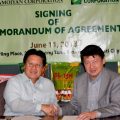A 3,000-hectare land had been planted to the high-yielding hybrid rice in La Paz, Tarlac with a government subsidy program that aims to make Tarlac an export-oriented agriculture trading center.
The aim of the local government units (LGU) of Tarlac—the provincial LGU and the La Paz town LGU— to make the province’s agricultural products export-bound is not impossible since Tarlac is already a known Philippine okra capital.
It exports some $7 million worth of okra to Japan from planting on some 200 hectares mainly from La Paz.
Consequently, a hybrid rice subsidy program may eventually enable the province to export rice to the United States.
This, though, should be fancy rice which is the rice type that is not banned to be exported from the Philippines
“We received a letter from a New York institution (Buona Vita) requesting us to provide a list of our rice producers since they want to import rice from us. We want to see what their requirements are because their inquiry shows their interest to do business with us,” said Dr. Edwina K. Tabamo, Tarlac provincial agriculturist.
Tarlac Gov. Victor A. Yap subsidized planting of SL-8H hybrid rice by P1,000 per bag per hectare for 500 hectares.
At the town level. La Paz Mayor Michael “Bong” M. Manuel provided another P1,000 subsidy per hectare for another 500 hectares for a combined total subsidy of P1 million.
Farmers in La Paz was convinced to shift to hybrid rice which is the answer to much of La Paz’ flooding problems.
As many La Paz rice farms are submerged in flood during the rainy season, they are only able to plant once a year. Their usual yearly was between 50 to 70 cavans per hectare. But hybrid rice practically doubles their harvest.
“With SL-8, they are able to harvest in one cropping what they would harvest in two croppings,” said Michelle Lim Gankee, SL Agritech Corp. (SLAC) assistant to the president.
Farmers also realized that the cost of inbred and hybrid seeds are about the same.
Inbreds cost only P1,200 per bag. But farmers have to buy three bags per cropping which raises their cost to P3,600 per hectare. With the subsidy from the government, SL-8H’s cost had been brought down to P3,800 per bag instead of P4,800.
Alfredo Magdangal, 68, one of Tarlac’s newly discovered outstanding farmers, confessed to having realized only now the value of hybrid rice. This is after 45 years that he has been planting rice.
In the dry cropping of 2012, he planted hybrid rice on his entire 21-hectare land. At an average of P100,000 net income per hectare, he netted around P1 million in his first try at hybrid rice farming.
This dry cropping season, though, he spent more money for fertilizer and irrigation since the absence of rain prompted him to pump up water, thereby spending for electricity. His expense increased from P25,000-P26,000 to P35,000-P40,000.
Yet, his net income was still at around P70,000 per hectare.
“The difference in our harvest is big,” said Magdangal in Filipino. “We didn’t believe in hybrid rice before. We couldn’t believe 18 kilos of seeds was enough for one hectare. We’re hesitant to put more money in seeds. But when I first tried it, I harvested 160 cavans. With inbred it was only 70 to 80 cavans.”
With his additional income, Magdangal is happy that he may now be able to buy another piece of land, while he is also presently building his dream house.
“I will no longer leave hybrid rice until I die,” he said.
Tarlac export strategy
The Tarlac provincial government wants to take advantage of Tarlac’s strategic proximity to the country’s biggest market, Metro Manila, being just one hour away to it through the expressways.
“Tarlac is sufficient in rice. We’re even exporting to other provinces,” said Tabamo. “We’re preparing to raise production more as we’re now constructing our first rice processing complex.”
The first complex—which will have a miller, dryer, and storage—is now being established in Amucao, Tarlac City. It costs P6 million. Two other rice complexes costing P16 million and P32 million are in the pipeline.
Tabamo said the development of hybrid rice areas in Tarlac can also be included in the $500 million Philippine Rural Development Program (RDP).
PRDP has the following components: farm to market roads, irrigation, and farm-related buildings.
For the first time since government promoted in 2001 hybrid rice as a flagship program to achieve food security, the Tarlac LGUs initiated support for it. SL-8H is now planted on 43 percent of La Paz’s 7,000-hectare rice land.
Manuel said La Paz is also asking SLAC for possible assistance on market for SL-8H.
“It’s the first time in 2010 that our local government supported hybrid rice. Before farmers weren’t yet aware (of the advantages) of hybrid rice,” said Manuel. “We just need to be assured that farmers will have a market. Yes (expansion is possible) especially with support for a market.”
La Paz further intensified its interest in hybrid rice since the Philippine Rice Research Institute (Philrice) and the Food and Agriculture Organization implemented in 2010 the program “Increasing Rice Yields and Productivity through the Promotion of Small-Scale Irrigation and Integrated Crop Management Systems in Rainfed Areas.” Its main interventions were cultural management and irrigation.
The use of high yielding seeds became the gap in this Philrice program which the LGU provided. Hybrid rice seeds are recognized by rice breeders as a major factor in raising yield contributing to at least 25 percent of incremental harvest.
###
ABOUT HYBRID RICE
Hybrid rice is a product of the breeding, or cross pollination, of two genetically different parents that have superior traits– for instance, one high-yielding and another one with grains that are aromatic (a palatable smell and taste). It is generally superior over inbred varieties that are a result of the mating of two very related parents that cannot offer much trait advantage. Inbreeding also comes naturally in the form of self-pollination that occurs in many plants– orchids, peas, and legumes like peanut. In these plants, male and female reproductive organs are within the same plant, enabling pollination within itself.
Hybrid rice production does not involve genetic modification as in genetically modified organisms, but it is considered a natural way of breeding through selection of plant materials that have the desired trait.
ABOUT SL AGRITECH CORP. (SLAC)
SLAC is the Philippines’ biggest producer of hybrid rice seeds and is the country’s pioneer in hybrid rice research and development (R&D). At a time when businesses veer away from agriculture owing to its inherent risks brought about by weather, nature-related, and calamity-related uncertainties, SLAC’s parent firm Sterling Group of Companies, stuck its neck out, took the risk, and invested capital in hybrid rice R&D. Today, SLAC produces popular hybrid rice seed SL-8H which has helped uplift the lives of many Filipino farmers through higher rice yield. By empowering them through training by SLAC technicians in precision farming skills and the pride to sell good-quality rice, many farmers are now able to educate their children, become farm entrepreneurs, and enjoy a higher standard of living. SLAC also produces the Dona Maria premium rice Miponica and Jasponica, the “best tasting rice in the Philippines, probably the whole world.” The company has international partnerships in Asia, the Pacific, and Africa in a humanitarian aim to help solve food security threats and global hunger.






